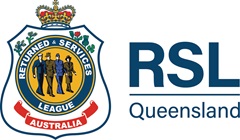
Rebuilding the League: the first 10 years of The Queensland Digger
04 June 2025- History & commemoration
Discover the origin story of Queensland RSL News.
In 2025, Queensland RSL News celebrates a centenary of telling the stories of Queensland’s veteran community. The publication’s lineage can be traced back to April 1925, when The Queensland Digger was officially issued.
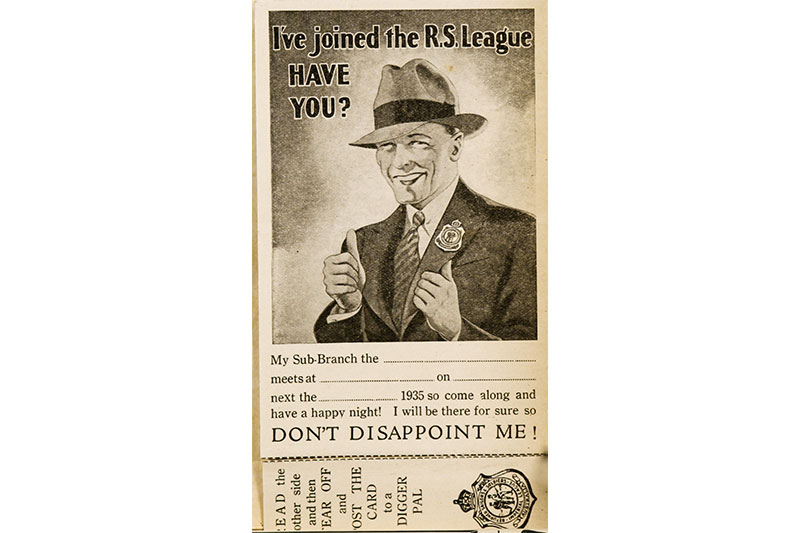
A detachable card that members were encouraged to mail to a returned mate. The Queensland Digger, 1 April 1935.
At this time, League membership was in crisis. The Queensland Digger performed a crucial role in rebuilding the Returned Sailors and Soldiers Imperial League of Australia (RSSILA) in Queensland over the first 10 years of its publication.
A critical drop in membership
By 1918, the RSSILA was the representative voice of the returned community in Australia. With the return of troops to Australia after WWI, support for the League surged. Membership in Queensland peaked at 15,000 in November 1919 and, nationwide, the RSSILA was 114,700 strong.
By the end of 1920, many State Branches were publishing their own journal: The Bayonet in Victoria; The Soldier in New South Wales; and, in Queensland, The Crusader.
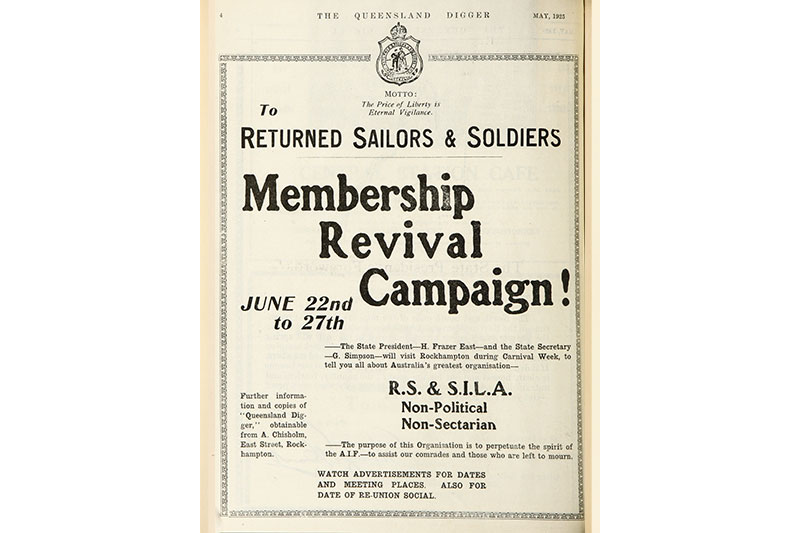
A membership campaign. The Queensland Digger, May 1925.
However, the successes of 1919 could not be sustained. In 1920, 53.5% of Queensland members did not renew their subscription and membership plunged from 15,000 to 6,967 men.
This trend played out across the nation and continued to spiral downwards until 1925 when only 20% of those recruited in 1919 remained financial. The political authority of the Federal Branch (now RSL Australia) remained unchanged, despite these losses. At a state, District and Sub Branch level, however, the reduction in both manpower and revenue seriously compromised the operations of the League.
The Crusader (1919-1924)
When the Crusader was first published in 1919, membership was soaring and the League held great hopes for its weekly publication. However, the Crusader was quickly beset with problems after it began publishing articles that were aggressively political in tone.
This conflicted with the non-partisan approach of the League and alienated many members. Advertisers withdrew their support, rival associations used the Crusader’s content to publicly criticise the RSSILA, members called for its axing and the publication failed to engage with a dwindling League membership.
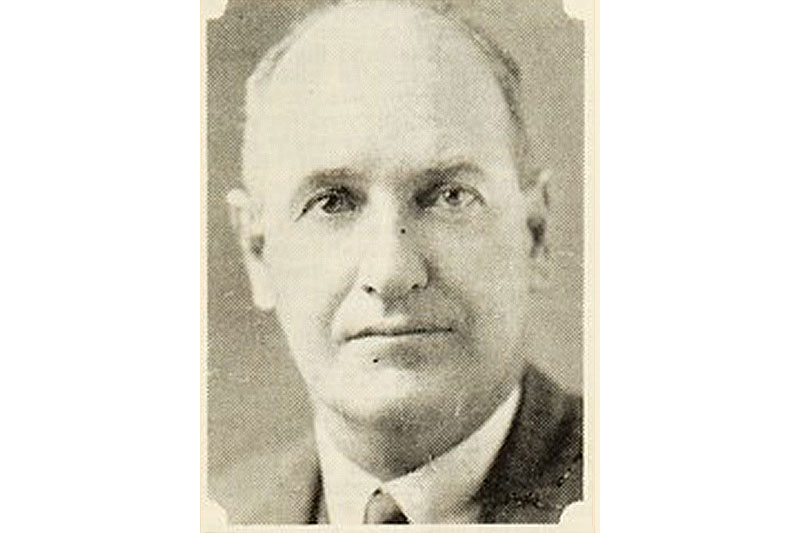
Hubert Frazer East introduced the first period of stability to the RSSILA in Queensland. Under his presidency, The Queensland Digger was launched in April 1925 and membership began increasing. Image: The Queensland Digger, 2 February 1942.
In February 1924, 31-year-old Hubert Frazer East was elected as State President. Frazer East was a respected and experienced Brisbane businessman and his six-year tenure as President represented the first extended period of stability and consolidation in the League’s short history.
Much to the relief of many, one of Frazer East’s first priorities was to cease publication of The Crusader. A new publication was developed and, in October 1924, a complimentary issue of The Queensland Digger was distributed to Sub Branches. Responses to the initiative were encouraging. In April 1925 – the 10th anniversary of the landing at Gallipoli – the RSSILA formally launched issue 1 of The Queensland Digger.
The Queensland Digger (1925-1962)
The League’s new monthly publication represented a powerful recruitment tool. By providing a central and non-partisan source of information about League activities, The Queensland Digger proved the benefits of membership to the State’s returned community.
Through the pages of The Queensland Digger, men stayed informed about the pensions and entitlements being negotiated with the government by the RSSILA. Activities, social events and unit reunions were advertised. The individual successes of returned men who had been supported into employment by the League were reported and members read about the distress relief provided to diggers and their families who were doing it tough.
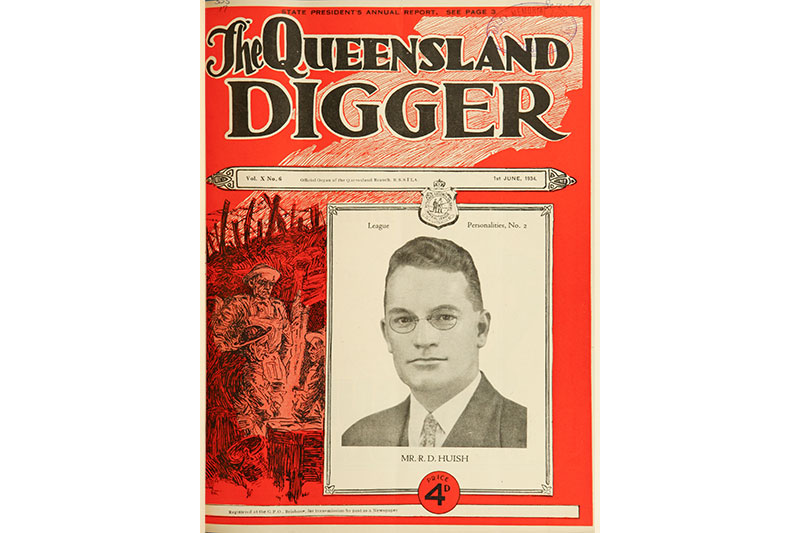
Raymond Huish succeeded Hubert Fraser East as President. He reformatted The Queensland Digger to broaden its appeal. The Queensland Digger, 1 June 1934.
As confidence in The Queensland Digger grew, members began contributing content; reminisces of service, along with profiles of important servicemen and campaigns, were popular. The length of the publication grew from 32 to 48 pages. Sub Branches sent monthly reports and soon a schedule of Sub Branch meetings and their locations was published in every issue.
Membership was an ever-present challenge and a regular topic in The Queensland Digger. The RSSILA depended almost exclusively upon its membership to grow the organisation. Readers were often reminded of their individual responsibility to build their League.
Details of the RSSILA’s ‘Revival Movement’ and other recruitment campaigns were published, along with the eligibility criteria for membership. Members were empowered to fulfil their responsibility with messaging such as, “One at a time is good going – get a new reader for the ‘Queensland Digger’ today” (July 1925).
Another threat appears
In December 1930, Frazer East stood down as President. The Queensland Digger was returning a modest profit and membership had increased by nearly 73%. Raymond Huish was elected President. The 32-year-old was also a managing director, and his experience was immediately put to test as he navigated the League through the immense challenges posed by the Great Depression.
It was not long before the effects of the prevailing economic crisis began eroding The Queensland Digger’s circulation and it began to barely break even. Huish reduced its length by one-third and its cost to two shillings.
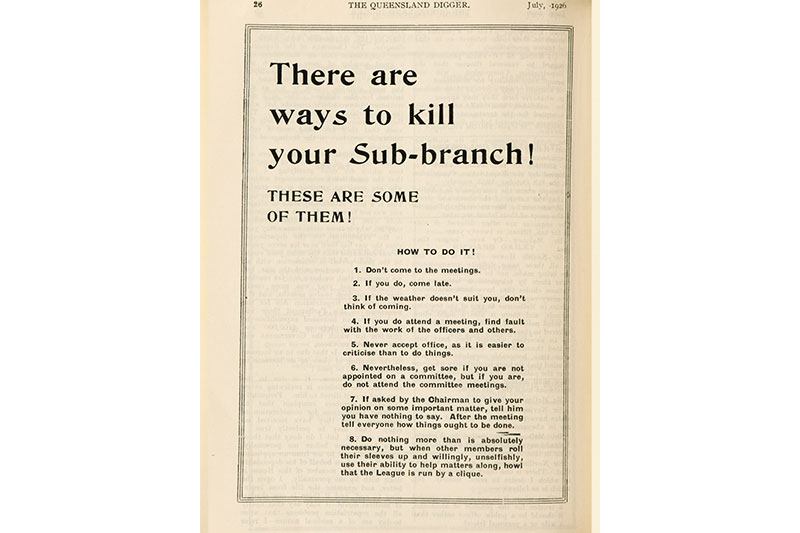
Tongue-in-cheek reminder of the dangers of irresponsible membership. The Queensland Digger, July 1926.
In February 1934, he relaunched The Queensland Digger with a fresh look and a larger format that increased content without increasing production costs. More than 81% of the men who had embarked with the AIF during WWI were single and, by the 1930s, many had married and were raising families.
Mindful of this change, Huish broadened the readership by including sections for women and a children’s page. He also expanded advertising to include female fashion and introduced special commemorative issues for Anzac and Armistice (later Remembrance) Days that featured striking cover art.
By the end of 1935 – four years after Huish assumed presidency, and despite the economic effects of the Great Depression – The Queensland Digger was again returning a profit and had contributed to a further 62% to League membership.
Magazine helps avert membership crisis
When the RSSILA introduced The Queensland Digger in 1925, its membership was at an all-time low and the League’s ability to provide support to the returned community was in crisis. A decade later – and under the capable leadership of Hubert Frazer East and Raymond Huish – The Queensland Digger had contributed to the steady growth of membership in Queensland.
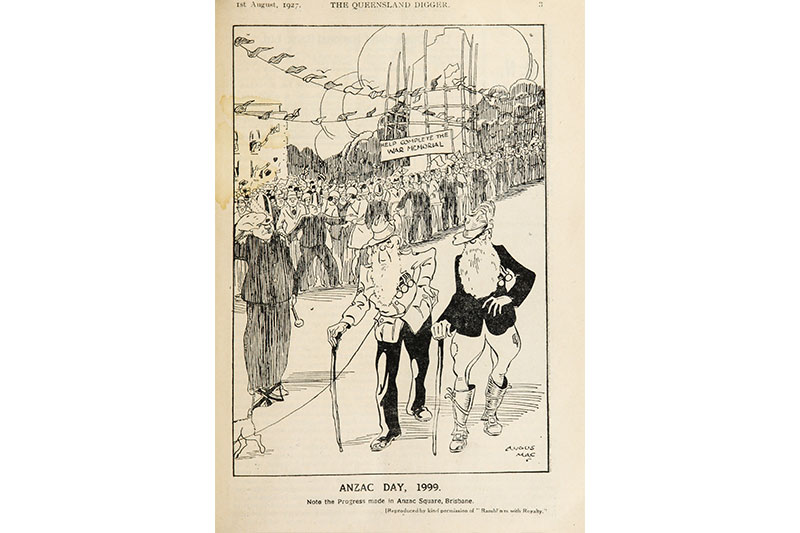
Humour was an essential element of The Queensland Digger. In 1927, it helped defray the returned community’s frustration over delays to the construction of Queensland’s National War Memorial: Anzac Square. The Queensland Digger, 1 August 1927.
One hundred years and several name changes later, Queensland RSL News continues the legacy of Queensland’s first successful League publication.
Related News
Loading
